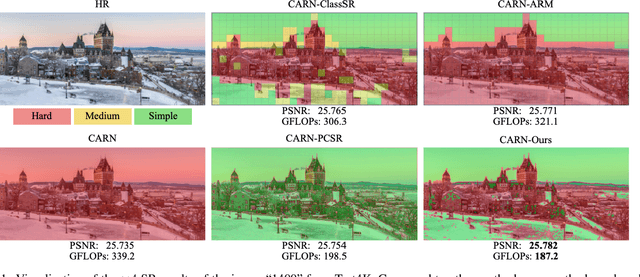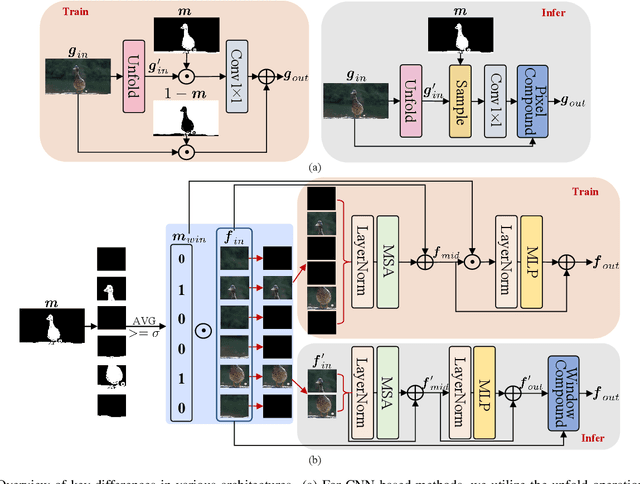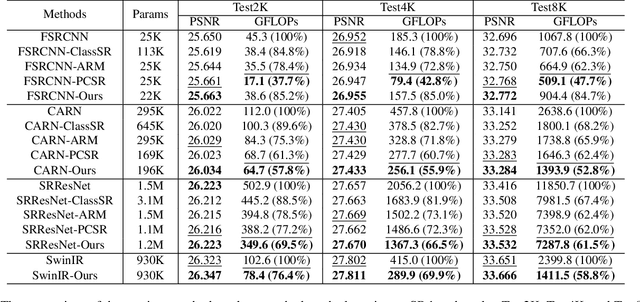Pengfei Zhu
StableIntrinsic: Detail-preserving One-step Diffusion Model for Multi-view Material Estimation
Aug 27, 2025Abstract:Recovering material information from images has been extensively studied in computer graphics and vision. Recent works in material estimation leverage diffusion model showing promising results. However, these diffusion-based methods adopt a multi-step denoising strategy, which is time-consuming for each estimation. Such stochastic inference also conflicts with the deterministic material estimation task, leading to a high variance estimated results. In this paper, we introduce StableIntrinsic, a one-step diffusion model for multi-view material estimation that can produce high-quality material parameters with low variance. To address the overly-smoothing problem in one-step diffusion, StableIntrinsic applies losses in pixel space, with each loss designed based on the properties of the material. Additionally, StableIntrinsic introduces a Detail Injection Network (DIN) to eliminate the detail loss caused by VAE encoding, while further enhancing the sharpness of material prediction results. The experimental results indicate that our method surpasses the current state-of-the-art techniques by achieving a $9.9\%$ improvement in the Peak Signal-to-Noise Ratio (PSNR) of albedo, and by reducing the Mean Square Error (MSE) for metallic and roughness by $44.4\%$ and $60.0\%$, respectively.
Motion-Aware Adaptive Pixel Pruning for Efficient Local Motion Deblurring
Jul 10, 2025Abstract:Local motion blur in digital images originates from the relative motion between dynamic objects and static imaging systems during exposure. Existing deblurring methods face significant challenges in addressing this problem due to their inefficient allocation of computational resources and inadequate handling of spatially varying blur patterns. To overcome these limitations, we first propose a trainable mask predictor that identifies blurred regions in the image. During training, we employ blur masks to exclude sharp regions. For inference optimization, we implement structural reparameterization by converting $3\times 3$ convolutions to computationally efficient $1\times 1$ convolutions, enabling pixel-level pruning of sharp areas to reduce computation. Second, we develop an intra-frame motion analyzer that translates relative pixel displacements into motion trajectories, establishing adaptive guidance for region-specific blur restoration. Our method is trained end-to-end using a combination of reconstruction loss, reblur loss, and mask loss guided by annotated blur masks. Extensive experiments demonstrate superior performance over state-of-the-art methods on both local and global blur datasets while reducing FLOPs by 49\% compared to SOTA models (e.g., LMD-ViT). The source code is available at https://github.com/shangwei5/M2AENet.
High-Frequency Prior-Driven Adaptive Masking for Accelerating Image Super-Resolution
May 11, 2025



Abstract:The primary challenge in accelerating image super-resolution lies in reducing computation while maintaining performance and adaptability. Motivated by the observation that high-frequency regions (e.g., edges and textures) are most critical for reconstruction, we propose a training-free adaptive masking module for acceleration that dynamically focuses computation on these challenging areas. Specifically, our method first extracts high-frequency components via Gaussian blur subtraction and adaptively generates binary masks using K-means clustering to identify regions requiring intensive processing. Our method can be easily integrated with both CNNs and Transformers. For CNN-based architectures, we replace standard $3 \times 3$ convolutions with an unfold operation followed by $1 \times 1$ convolutions, enabling pixel-wise sparse computation guided by the mask. For Transformer-based models, we partition the mask into non-overlapping windows and selectively process tokens based on their average values. During inference, unnecessary pixels or windows are pruned, significantly reducing computation. Moreover, our method supports dilation-based mask adjustment to control the processing scope without retraining, and is robust to unseen degradations (e.g., noise, compression). Extensive experiments on benchmarks demonstrate that our method reduces FLOPs by 24--43% for state-of-the-art models (e.g., CARN, SwinIR) while achieving comparable or better quantitative metrics. The source code is available at https://github.com/shangwei5/AMSR
Bi-directional Self-Registration for Misaligned Infrared-Visible Image Fusion
May 11, 2025Abstract:Acquiring accurately aligned multi-modal image pairs is fundamental for achieving high-quality multi-modal image fusion. To address the lack of ground truth in current multi-modal image registration and fusion methods, we propose a novel self-supervised \textbf{B}i-directional \textbf{S}elf-\textbf{R}egistration framework (\textbf{B-SR}). Specifically, B-SR utilizes a proxy data generator (PDG) and an inverse proxy data generator (IPDG) to achieve self-supervised global-local registration. Visible-infrared image pairs with spatially misaligned differences are aligned to obtain global differences through the registration module. The same image pairs are processed by PDG, such as cropping, flipping, stitching, etc., and then aligned to obtain local differences. IPDG converts the obtained local differences into pseudo-global differences, which are used to perform global-local difference consistency with the global differences. Furthermore, aiming at eliminating the effect of modal gaps on the registration module, we design a neighborhood dynamic alignment loss to achieve cross-modal image edge alignment. Extensive experiments on misaligned multi-modal images demonstrate the effectiveness of the proposed method in multi-modal image alignment and fusion against the competing methods. Our code will be publicly available.
DC-SAM: In-Context Segment Anything in Images and Videos via Dual Consistency
Apr 16, 2025Abstract:Given a single labeled example, in-context segmentation aims to segment corresponding objects. This setting, known as one-shot segmentation in few-shot learning, explores the segmentation model's generalization ability and has been applied to various vision tasks, including scene understanding and image/video editing. While recent Segment Anything Models have achieved state-of-the-art results in interactive segmentation, these approaches are not directly applicable to in-context segmentation. In this work, we propose the Dual Consistency SAM (DC-SAM) method based on prompt-tuning to adapt SAM and SAM2 for in-context segmentation of both images and videos. Our key insights are to enhance the features of the SAM's prompt encoder in segmentation by providing high-quality visual prompts. When generating a mask prior, we fuse the SAM features to better align the prompt encoder. Then, we design a cycle-consistent cross-attention on fused features and initial visual prompts. Next, a dual-branch design is provided by using the discriminative positive and negative prompts in the prompt encoder. Furthermore, we design a simple mask-tube training strategy to adopt our proposed dual consistency method into the mask tube. Although the proposed DC-SAM is primarily designed for images, it can be seamlessly extended to the video domain with the support of SAM2. Given the absence of in-context segmentation in the video domain, we manually curate and construct the first benchmark from existing video segmentation datasets, named In-Context Video Object Segmentation (IC-VOS), to better assess the in-context capability of the model. Extensive experiments demonstrate that our method achieves 55.5 (+1.4) mIoU on COCO-20i, 73.0 (+1.1) mIoU on PASCAL-5i, and a J&F score of 71.52 on the proposed IC-VOS benchmark. Our source code and benchmark are available at https://github.com/zaplm/DC-SAM.
Dream-IF: Dynamic Relative EnhAnceMent for Image Fusion
Mar 13, 2025Abstract:Image fusion aims to integrate comprehensive information from images acquired through multiple sources. However, images captured by diverse sensors often encounter various degradations that can negatively affect fusion quality. Traditional fusion methods generally treat image enhancement and fusion as separate processes, overlooking the inherent correlation between them; notably, the dominant regions in one modality of a fused image often indicate areas where the other modality might benefit from enhancement. Inspired by this observation, we introduce the concept of dominant regions for image enhancement and present a Dynamic Relative EnhAnceMent framework for Image Fusion (Dream-IF). This framework quantifies the relative dominance of each modality across different layers and leverages this information to facilitate reciprocal cross-modal enhancement. By integrating the relative dominance derived from image fusion, our approach supports not only image restoration but also a broader range of image enhancement applications. Furthermore, we employ prompt-based encoding to capture degradation-specific details, which dynamically steer the restoration process and promote coordinated enhancement in both multi-modal image fusion and image enhancement scenarios. Extensive experimental results demonstrate that Dream-IF consistently outperforms its counterparts.
Target-driven Self-Distillation for Partial Observed Trajectories Forecasting
Jan 28, 2025Abstract:Accurate prediction of future trajectories of traffic agents is essential for ensuring safe autonomous driving. However, partially observed trajectories can significantly degrade the performance of even state-of-the-art models. Previous approaches often rely on knowledge distillation to transfer features from fully observed trajectories to partially observed ones. This involves firstly training a fully observed model and then using a distillation process to create the final model. While effective, they require multi-stage training, making the training process very expensive. Moreover, knowledge distillation can lead to a performance degradation of the model. In this paper, we introduce a Target-driven Self-Distillation method (TSD) for motion forecasting. Our method leverages predicted accurate targets to guide the model in making predictions under partial observation conditions. By employing self-distillation, the model learns from the feature distributions of both fully observed and partially observed trajectories during a single end-to-end training process. This enhances the model's ability to predict motion accurately in both fully observed and partially observed scenarios. We evaluate our method on multiple datasets and state-of-the-art motion forecasting models. Extensive experimental results demonstrate that our approach achieves significant performance improvements in both settings. To facilitate further research, we will release our code and model checkpoints.
Towards Robust Unsupervised Attention Prediction in Autonomous Driving
Jan 25, 2025Abstract:Robustly predicting attention regions of interest for self-driving systems is crucial for driving safety but presents significant challenges due to the labor-intensive nature of obtaining large-scale attention labels and the domain gap between self-driving scenarios and natural scenes. These challenges are further exacerbated by complex traffic environments, including camera corruption under adverse weather, noise interferences, and central bias from long-tail distributions. To address these issues, we propose a robust unsupervised attention prediction method. An Uncertainty Mining Branch refines predictions by analyzing commonalities and differences across multiple pre-trained models on natural scenes, while a Knowledge Embedding Block bridges the domain gap by incorporating driving knowledge to adaptively enhance pseudo-labels. Additionally, we introduce RoboMixup, a novel data augmentation method that improves robustness against corruption through soft attention and dynamic augmentation, and mitigates central bias by integrating random cropping into Mixup as a regularizer.To systematically evaluate robustness in self-driving attention prediction, we introduce the DriverAttention-C benchmark, comprising over 100k frames across three subsets: BDD-A-C, DR(eye)VE-C, and DADA-2000-C. Our method achieves performance equivalent to or surpassing fully supervised state-of-the-art approaches on three public datasets and the proposed robustness benchmark, reducing relative corruption degradation by 58.8% and 52.8%, and improving central bias robustness by 12.4% and 11.4% in KLD and CC metrics, respectively. Code and data are available at https://github.com/zaplm/DriverAttention.
Asymmetric Reinforcing against Multi-modal Representation Bias
Jan 02, 2025



Abstract:The strength of multimodal learning lies in its ability to integrate information from various sources, providing rich and comprehensive insights. However, in real-world scenarios, multi-modal systems often face the challenge of dynamic modality contributions, the dominance of different modalities may change with the environments, leading to suboptimal performance in multimodal learning. Current methods mainly enhance weak modalities to balance multimodal representation bias, which inevitably optimizes from a partialmodality perspective, easily leading to performance descending for dominant modalities. To address this problem, we propose an Asymmetric Reinforcing method against Multimodal representation bias (ARM). Our ARM dynamically reinforces the weak modalities while maintaining the ability to represent dominant modalities through conditional mutual information. Moreover, we provide an in-depth analysis that optimizing certain modalities could cause information loss and prevent leveraging the full advantages of multimodal data. By exploring the dominance and narrowing the contribution gaps between modalities, we have significantly improved the performance of multimodal learning, making notable progress in mitigating imbalanced multimodal learning.
Efficient Masked AutoEncoder for Video Object Counting and A Large-Scale Benchmark
Nov 20, 2024



Abstract:The dynamic imbalance of the fore-background is a major challenge in video object counting, which is usually caused by the sparsity of foreground objects. This often leads to severe under- and over-prediction problems and has been less studied in existing works. To tackle this issue in video object counting, we propose a density-embedded Efficient Masked Autoencoder Counting (E-MAC) framework in this paper. To effectively capture the dynamic variations across frames, we utilize an optical flow-based temporal collaborative fusion that aligns features to derive multi-frame density residuals. The counting accuracy of the current frame is boosted by harnessing the information from adjacent frames. More importantly, to empower the representation ability of dynamic foreground objects for intra-frame, we first take the density map as an auxiliary modality to perform $\mathtt{D}$ensity-$\mathtt{E}$mbedded $\mathtt{M}$asked m$\mathtt{O}$deling ($\mathtt{DEMO}$) for multimodal self-representation learning to regress density map. However, as $\mathtt{DEMO}$ contributes effective cross-modal regression guidance, it also brings in redundant background information and hard to focus on foreground regions. To handle this dilemma, we further propose an efficient spatial adaptive masking derived from density maps to boost efficiency. In addition, considering most existing datasets are limited to human-centric scenarios, we first propose a large video bird counting dataset $\textit{DroneBird}$, in natural scenarios for migratory bird protection. Extensive experiments on three crowd datasets and our $\textit{DroneBird}$ validate our superiority against the counterparts.
 Add to Chrome
Add to Chrome Add to Firefox
Add to Firefox Add to Edge
Add to Edge